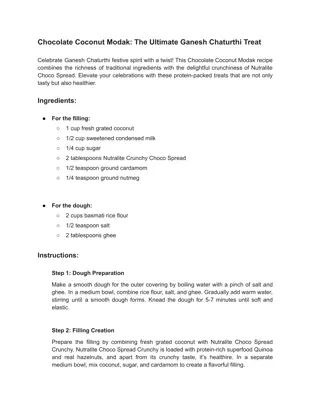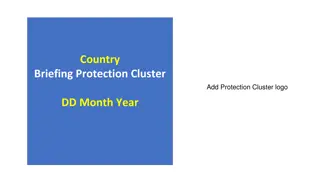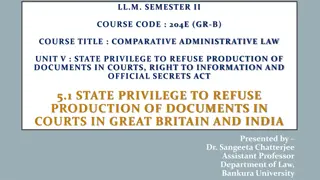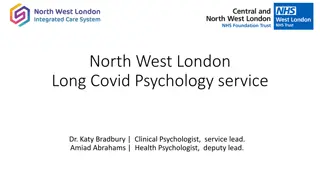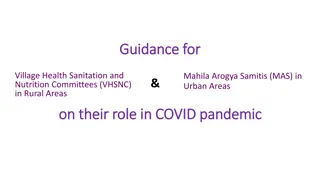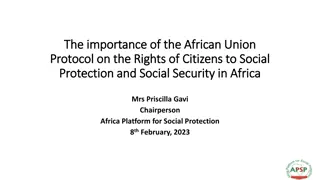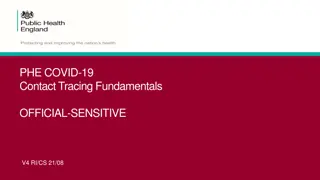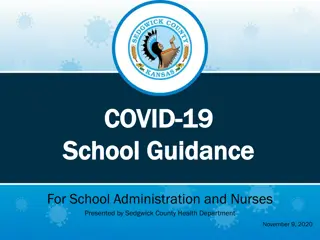Understanding COVID-19: Protection, Spread, and Right to Refuse
COVID-19, caused by SARS-CoV-2, presents symptoms ranging from mild to severe. The prevailing consensus suggests close contact as the primary mode of spread. Recommendations include treating it as an airborne transmitted disease. Effective sanitization methods and the provision of appropriate PPE are essential. The right to refuse work due to safety concerns is emphasized, with guidelines for protection and precautions detailed.
Download Presentation

Please find below an Image/Link to download the presentation.
The content on the website is provided AS IS for your information and personal use only. It may not be sold, licensed, or shared on other websites without obtaining consent from the author. Download presentation by click this link. If you encounter any issues during the download, it is possible that the publisher has removed the file from their server.
E N D
Presentation Transcript
COVID-19 and Right to Refuse Troy Winters, CRSP Senior Officer, CUPE National Health & Safety Branch
COVID-19 COVID-19 is caused by a virus from the same family as the SARS (severe acute respiratory syndrome) coronavirus, SARS-CoV-2 Symptoms are similar to a cold or flu can range from mild to severe and include: Fever Cough Difficulty breathing The prevailing consensus is that time between infection and the onset of clinical symptoms of the disease is 1 -12 days.
COVID-19 - Spread The prevailing consensus among health agencies that the virus is spread primarily through close contact (within 2 meters) with an infected person through respiratory droplets generated when a person, for example, coughs or sneezes, or through droplets of saliva or discharge from the nose. There remains no true consensus if COVID-19 is transmitted by airborne particles As such, CUPE is recommending that workers and the JHSC treat COVID-19 as an airborne transmitted disease.
SANITIZING Based on the currently available scientific evidence, chemical disinfectants that are effective for decontamination of SARS-CoV-2 (when they are used according to manufacturer s directions ) include. sodium hypochlorite (bleach), 70% ethanol, 0.5% hydrogen peroxide, quaternary ammonium and phenolic compounds. It is possible that other biocidal agents may be less effective (e.g., 0.05-0.2% benzalkonium chloride, 0.02% chlorhexidine digluconate). Health Canada
COVID-19 - Protection There is not a scientific consensus on the appropriate level of respiratory protection All workers who are within two metres of suspected, presumed or confirmed COVID19 patients shall have access to appropriate PPE.
For close (2m) or extended contact Airborne Precautions A fit-tested, seal-checked N95 respirator covering the nose and mouth Eye protection when within two meters. Gloves and gown. Additionally, client/patient/ resident should wear a mask when tolerated, and when outside his or her room or the care area and hand hygiene performed on exiting the room.
More information See https://cupe.ca/covid-19
Right to Refuse 3-31 A worker may refuse to perform any particular act or series of acts at a place of employment if the worker has reasonable grounds to believe that the act or series of acts is unusually dangerous to the worker s health or safety or the health or safety of any other person at the place of employment until: (a) sufficient steps have been taken to satisfy the worker otherwise; or (b) the occupational health committee has investigated the matter and advised the worker otherwise.
Right to Refuse - interpretation Workers have the RtR to do any specific job or task which they have reasonable grounds to believe is unusually dangerous. The danger may be to you or to any other person. An unusual danger could include: A danger that is not normal for the job; A danger that would normally stop work); or A situation for which you are not properly trained, equipped, or experienced to do the work assigned.
RtR Steps 1. Tell your employer/supervisor that you are refusing work because of a health or safety concern. 2. Do not leave the worksite without your employer's permission. 3. Contact your occupational health committee (OHC) or OHS representative if you cannot resolve the concern with the employer/supervisor.
RtR Steps 4. Your OHC will investigate the refusal, meet and vote to determine if you have reasonable grounds to refuse the work. (The vote must be unanimous for or against the refusal.). 5. If the concern cannot be resolved within your workplace, contact an occupational health officer at the Occupational Health and Safety Division. 6. The officer will investigate the refusal and rule on the matter.




